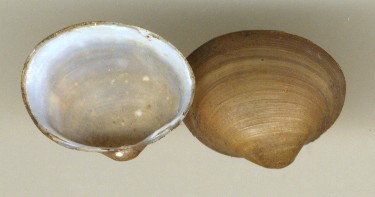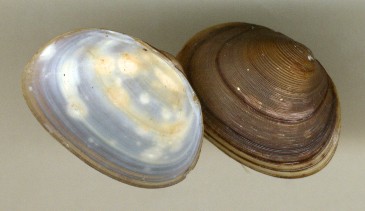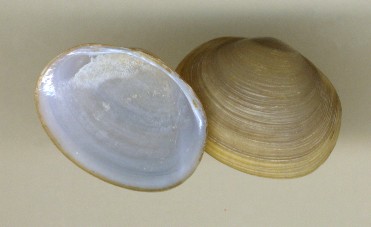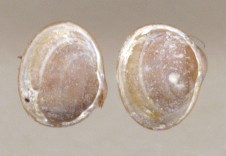Freshwater Molluscan Shells Sphaeriidae
|
Freshwater Molluscan Shells
Sphaeriidae
These are small usually colorless clams of worldwide distribution. Members of the subfamily Sphaeriinae are referred to as fingernail clams, while the even smaller Pisidiinae are pea or pill clams. Species are distinguished on the basis of shell shape, presence and nature of striations, and details of hinge teeth structure. They inhabit ponds, swamps, and creeks.
Classification
Banarescu and McMahon include the Sphaeriidae as a family together with the family Corbiculidae in the superfamily Corbiculacea (or Sphaeriacea of Burch, 1972). Recent DNA work (Internet posting by David Campbell on Conch-L, May 22, 2000) however, indicates that the Sphaeriidae and Corbiculidae are not closely related. For North America, they are further divided into subgenera by Burch (below):
Family Sphaeriidae (Pisidiidae)
Subfamily Sphaeriinae
.....Sphaerium; 12 North American species.
..........Sphaerium s.s. Almost all of North America, Europe, and Asia, 8 N.A. species.
..........Musculium Almost all of North America, Europe, and Asia, 4 N.A. species.
Subfamily Euperiinae
.....Eupera; Africa, South America, southern North America, 1 N.A. species.
Subfamily Pisidiinae
.....Pisidium; 25 North American species.
..........Pisidium s.s. Holarctic, 3 North American species.
..........Cyclocalyx Some species are nearly cosmopolitan in distribution, 17 N.A. species.
..........Neopisidium Almost all of Europe, Asia, and North America, 5 N.A. species.Banarescu raises Burch's subgeneric taxa to generic status, and also includes the following non-North American genera in his worldwide synthesis and mapping:
Subfamily Sphaeriinae;
.....Amesoda; much of Siberia
.....Sphaeriastrum; Europe and western Siberia
.....Serratisphaerium; much of central Africa
.....Pseudocorbicula; eastern Africa, and
.....Zecyclas; New Zealand.
Subfamily Euperiinae;
.....Byssanodonta; Parana River Basin.
Subfamily Pisidiinae;
.....Odherpisidium; southern Asia, southern Europe
.....Afropisidium; almost all of central Africa, southeast Asia
.....Parapisidium; endemic to island of Nosse Be near Madagascar, and
.....Australpera; south Australia and Tasmania.
All sphaeriaceans are hermaphroditic, capable of self-fertilization, and ovoviviparous, brooding embryos in gill invaginations. The number of young per brood are relatively small for invertebrates, and the juvenile individuals released into the environment large in size. McMahon mentions one species only 4 mm in length that releases young 1.4 mm long. In many species, there may be juveniles of more than one size in a single adult individual.

Sphaerium (Musculium) partumeium (Say, 1822) Most of North America. x4.

Sphaerium (Sphaerium) simile (Say, 1816) Southern Canada and northern United States.

Sphaerium rivicola (Lamarck, 1811) Hungary. x4, and x8.
Sphaerium argentinum D'Orbigny Uruguay
African Sphaeriidae. Images from Pilsbry and Becquaert, 1927. They list six species plus one additional subspecies for Eupera, eight species of Pisidium, and 18 species plus one additional subspecies for Sphaerium. Eupera is often found living in the cavities in the shells of Etheria elliptica, the river oyster.
Sphaerium
Stuhlmanni
E. v. Martens
1897. 12 mm.
Eupera mediafricana
Pilsbry and Becquaert,
1927. 5 mm.
The Euperiinae differ from the Pisidiinae and Sphaeriinae in a number of ways, the most conspicuous are the presence of a functioning byssal gland, and only one cardinal tooth on each valve. On the coastal plain of the United States, Eupera cubensis ranges from North Carolina to southern Texas.
Eupera cubensis (Prime, 1865) These small clams were found
in a still water bayou in northeastern Arkansas, clinging by means
of their byssal threads to leaves that had fallen into shallow water. x8.
Upper right specimen shows inside of shell.

Pisidium (cyclocalyx) casertanum
(Poli, 1795) x8 has a nearly worldwide
distribution.Unknown Pisidium species,
spring-fed East Tennessee creek. x8.